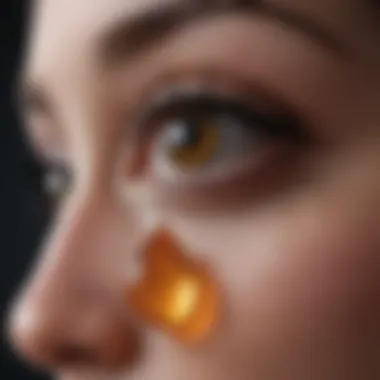Evaluating the Safety of Lumify Eye Drops


Intro
In today's world, where first impressions often hinge on how we present ourselves, having clear, vibrant eyes can significantly affect our confidence and overall well-being. For many, red eyes can be a nuisance, signaling fatigue, allergy triggers, or other irritations. Enter Lumify Drops, a widely-used over-the-counter solution aimed at alleviating this common issue. Though they are readily accessible, the question that looms large over every consumer’s mind is: How safe is this product?
This article sets out on a path to thoroughly assess the safety profile of Lumify drops. We will explore their chemical composition, potential side effects, and expert opinions on their usage. Moreover, we'll offer practical guidelines for effective use while sifting through the safety concerns tied to their long-term application. The aim is to empower you, the reader, with knowledge—you deserve to make informed choices about what you put in your body, especially when it comes to something as sensitive as your eyes.
"Knowledge is power, and understanding our options is crucial in making sound decisions about our health and well-being."
As we embark on this exploration, every section is designed to provide clear insights, addressing prevalent worries and misconceptions surrounding Lumify drops. Whether you are contemplating their use for the first time or are a seasoned user looking to enhance your understanding, this comprehensive review will serve as a valuable resource.
Stay tuned as we dive deeper into the details, unraveling the layers that wrap around this popular eye drop solution.
Prolusion to Lumify Drops
In the realm of eye health, red-eye relief is a common topic of discussion, particularly for those who often find themselves battling irritated eyes. Lumify Drops have surfaced as a well-known solution for this dilemma, captivating many with their promise of alleviating redness effectively. This introduction sets the stage for a comprehensive exploration into what Lumify Drops are, their function, and why understanding their safety is crucial for consumers.
It's noteworthy that red-eye conditions don’t just stem from the obvious sources like allergies or lack of sleep. Stress, screen time, and environmental factors also play pivotal roles in affecting eye appearance. As such, products like Lumify Drops provide not only a cosmetic fix but also a boost to comfort, improving overall well-being.
Why dive deep into Lumify Drops? Well, usage of over-the-counter solutions requires informed decision-making. Many consumers may not fully understand the potential implications of frequent use or the underlying ingredients. This article aims to shed light on those considerations, helping readers weigh the benefits of Lumify Drops against any risks.
Through the following sections, we’ll unravel the specifics of Lumify Drops, desecrating the various elements involved from their chemical make-up to expert insights, and offer practical guidance. Preparing oneself for informed product choice is a powerful advantage, as knowledge in this arena leads to empowered consumer behavior.
What Are Lumify Drops?
Lumify Drops, officially known as brimonidine tartrate ophthalmic solution 0.025%, are specifically designed to reduce eye redness. These drops function by targeting the tiny blood vessels in the eye that become enlarged in response to irritation. By constricting these vessels, Lumify provides rapid relief of redness, acting almost like a magic wand for those needing a quick fix before an important meeting or event.
These drops are marketed as safe for over-the-counter use, making them accessible to a wide audience. For many women who juggle professional and personal commitments, ease of access is a significant advantage. However, it’s essential to scrutinize the claims made by over-the-counter products, as the ease of availability doesn’t always correlate with safety.
How Lumify Drops Work
So how exactly do Lumify Drops do their work? The primary weapon in their arsenal is brimonidine, a selective alpha-2 adrenergic agonist. While that sounds technical, the essence is that this ingredient interacts with certain receptors in the eye, leading to the constriction of blood vessels. In layman’s terms, this means it helps to shrink the swollen vessels and diminish that unwanted redness.
The effects of the drops kick in usually within minutes and can last for up to eight hours, providing an extended period of relief. However, many individuals may not be aware that too much of a good thing can sometimes backfire. Overusing these drops may lead to rebound redness, where the eyes become redder upon cessation of use.
It’s critical then, that while Lumify provides a quick fix, consumers must also be cautioned on responsible usage. Understanding the biochemistry at play not only empowers users but also fosters a healthy respect for usage guidelines that exist to protect their ocular health.
Chemical Composition of Lumify Drops
Understanding the chemical composition of Lumify drops is fundamental to evaluating its safety and efficacy. These drops are not merely a concoction of random substances; rather, they are meticulously formulated to provide relief from red eyes through the means of specific active and inactive ingredients. Gaining insights into these components can help users make informed choices on whether to integrate Lumify drops into their eye care regimen.
Active Ingredients
The primary active ingredient in Lumify drops is brimonidine tartrate. This compound is widely recognized for its effectiveness in reducing redness by constricting blood vessels in the eye. It acts swiftly, typically showing results within minutes, which is essential for those who seek instant relief.
The utilization of brimonidine tartrate is noteworthy for several reasons:
- Fast Acting: Many users report rapid improvement after application, providing a soothing experience when they need it the most.
- Selective Action: Unlike some other redness-reducing agents, brimonidine targets specific receptors, minimizing the chances of rebound redness—a common pitfall of similar eye drops.
- Limited Systemic Absorption: This means that the compound remains largely localized to the eyes, which is beneficial for mitigating potential side effects.
While Lumify drops are quite effective, it's always prudent to be aware of individual allergic reactions. Always consult a healthcare provider if uncertain.
Inactive Ingredients
In addition to the active ingredient, Lumify drops have a variety of inactive ingredients that assist in the formulation, stability, and overall experience of using the drops. These ingredients, while not responsible for the active therapeutic effect, play essential roles:
- Preservatives: Often included to prevent microbial growth, which ensures the integrity of the drops over time. Products like sodium chloride and benzalkonium chloride may appear here, though the formulation is designed to limit irritancy.
- Buffers: Agents like sodium phosphate help maintain the pH of the solution, ensuring that it aligns with natural tear fluid, thus enhancing comfort on application.
- Tonicity Agents: Ingredients like sodium chloride also help in adjusting the osmolarity of the solution to make sure it doesn’t irritate sensitive eye tissues.


These inactive components are equally important as the active ingredient. They work harmoniously to deliver a comfortable and effective solution for red eyes.
"The effectiveness of any pharmaceutical product often lies in its formulation—not just what it does, but how well its elements cooperate."
By grasping the significance of the chemical makeup of Lumify drops, consumers can confidently engage with their eye health.
Potential Side Effects of Lumify Drops
Understanding the potential side effects of Lumify Drops is an essential aspect of ensuring safe usage, especially for women who might be more cautious about any product impacting their health. Knowing how these drops can interact with individuals not only helps in recognizing when something may be amiss, but also enhances overall peace of mind when using them for red-eye relief. The side effects can range from common, manageable discomforts to rare but serious reactions. Covering these potential side effects provides a well-rounded view of what consumers might expect when integrating Lumify into their routines.
Common Side Effects
When using Lumify Drops, users may experience a few common side effects. Understanding these can help demystify any initial concern upon application. Below are some frequently reported effects:
- Mild Eye Irritation: Some users report a slight burning sensation after instilling the drops. This is usually short-lived.
- Dryness or Discomfort: A feeling of dryness in the eye might occur, particularly after extended use.
- Pupil Dilation: Users might notice their pupils getting slightly larger; this is a typical effect from the active ingredient.
These common side effects are often mild and do not typically require cessation of use. However, for anyone who finds that the discomfort persists or worsens, it should raise a flag, indicating it may be time to consult with a healthcare professional.
Serious Reactions
Serious reactions to Lumify Drops are relatively rare. Though it’s crucial to shed light on them, as understanding the full spectrum of potential reactions can empower users to act swiftly if needed. Some serious side effects to be aware of include:
- Severe Allergic Reactions: Symptoms can manifest as swelling in the face or throat, rash, or difficulty breathing. If any of these occur, immediate medical attention is necessary.
- Increased Eye Pressure: For those with preexisting eye conditions, Lumify might exacerbate high eye pressure, leading to severe headaches or vision changes.
- Vision Changes: Although not common, any sudden alterations in vision after using the product should prompt a quick consultation with an eye specialist.
"While most users tolerate Lumify Drops well, it's never a bad idea to be proactive about one's health. Awareness is key."
Recognizing these serious reactions can not only save one’s sight but also avoid unnecessary health complications. Educating oneself on the risks associated with Lumify Drops enhances the overall safety profile consumers can expect and is vital in making informed decisions about eye care.
Expert Opinions on Lumify Drops
When consumers consider using Lumify drops, seeking expert opinions is essential. These insights guide individuals in understanding the product's implications on eye health. Given that drugs and treatments can significantly impact well-being, professional evaluations offer a much-needed layer of assurance. From trusts in effectiveness to concerns over safety, experts help navigate the often murky waters of personal health choices.
Ophthalmologists' Insights
Ophthalmologists play a pivotal role in assessing the safety and efficacy of Lumify drops. These specialists, trained extensively in the field of eye care, usually emphasize the importance of not only using products as directed but also understanding the active ingredients. In the case of Lumify, the main component, brimonidine tartrate, works by narrowing blood vessels, providing a quick relief from redness.
However, professionals often highlight that it’s easy to overlook possible side effects like dry eyes or allergic reactions, particularly in those with pre-existing conditions. Often, they recommend discussing one's health history before embarking on a new treatment plan. This isn’t just a safety measure; it’s also about understanding how products interact with other medications or existing conditions. In their view, the decision to use Lumify should stem from a broader understanding of one’s individual health needs.
"While immediate relief can be alluring, it's vital to keep long-term eye health in mind. Consulting a specialist can provide clarity,” says Dr. Jane Smith, a seasoned ophthalmologist.
Pharmacists' Perspectives
Pharmacists, often the unsung heroes of the healthcare system, provide a unique view about Lumify drops. Their training enables them to advise patients about the safe handling and administration of eye drops. They commonly stress the importance of reading labels and adhering to the dosage guidelines. For instance, many users are inclined to apply more than the recommended amount, thinking it will enhance effectiveness; however, this can lead to complications.
From their vantage point behind the pharmacy counter, they frequently bear witness to customer experiences—both positive and negative. Many pharmacists note that regular use is often accompanied by warnings about rebound redness. They advise users to be cautious and monitor how their eyes respond over time. Furthermore, they can provide information on alternative products, which may be beneficial for those looking for options.
For instance, they might suggest considering artificial tears for those experiencing dryness or irritation alongside redness. The dialogue between pharmacists and customers tends to empower individuals, allowing them to make informed decisions based on personal needs and experiences.
In summary, gathering insights from both ophthalmologists and pharmacists about Lumify drops proves invaluable. Their combined expertise fosters a culture of informed decision-making and proactive eye health management.
Guidelines for Safe Usage of Lumify Drops
When it comes to using eye drops like Lumify, adhering to safety guidelines is paramount. Using these drops correctly not only maximizes their effectiveness but also minimizes the risk of adverse effects. This section will lay out some essential dos and don'ts to keep your eyes comfortable while avoiding unnecessary complications.
Dosage Instructions
The dosage for Lumify drops is crucial to achieving the desired results without introducing side effects. Typically, the recommended dosage is one drop in each affected eye. It's vital to avoid exceeding the recommended dosage. Overusing drops can lead to rebound redness, a phenomenon where the very symptoms one aims to treat may worsen after prolonged or excessive use.


"Less is more when it comes to ocular medications—following the prescribed dosage can make all the difference!"
Make sure to wash your hands before handling the drops to prevent introducing bacteria. When administering the drops, tilt your head back slightly, pull down on your lower eyelid, and squeeze the bottle gently to release a drop into your eye.
Frequency of Application
Understanding how often to apply Lumify drops is just as vital as knowing the correct dosage. The company usually recommends using these drops no more than four times a day. Sticking to this frequency can help at the beginning. However, if you find yourself needing to use Lumify drops daily for an extended period, it might be smart to check in with a healthcare provider. Regular usage beyond the recommended frequency may indicate an underlying issue that needs attention.
Another aspect to consider is to keep track of how your eyes feel after using the drops. If you notice that the redness is not easing or you are relying on the drops frequently, consult an eye care professional for further advice.
Storage Recommendations
Proper storage of Lumify drops can affect their potency. It is essential to keep the container sealed tightly and store it at room temperature, away from excessive heat or moisture. Avoid exposing the drops to very cold temperatures, as this can affect their efficacy.
Expiring medications can be a potential source of issues, so always check the expiration date on the bottle. Discard any unused drops after the expiration date has passed. This practice ensures that you are using medication that is both safe and effective.
Normal room conditions will help maintain the drops' integrity, ensuring they provide you with relief when you need it most.
Following these guidelines will help you use Lumify drops safely and effectively, allowing you to focus on what matters most—clarity and comfort in your vision.
Addressing Safety Concerns
Understanding the safety of Lumify drops is not just an academic exercise; it's crucial for anyone considering using them. Eye drops that relieve red eye symptoms have become ubiquitous, but with widespread use comes the necessity to scrutinize their safety profile thoroughly. This segment focuses on two key areas—long-term use implications and the use of Lumify in vulnerable populations. Both facets are essential as they highlight potential risks, specific conditions for safe usage, and the overall impact on various demographics. Through a detailed exploration of these elements, we can provide readers with the necessary insights to make informed decisions regarding their eye care needs.
Long-Term Use Implications
The topic of long-term use of Lumify drops raises important considerations. Many individuals opt for these drops for quick relief, often overlooking the potential consequences of prolonged use. One unexpected side effect that can occur includes dependency, where the eyes begin to rely on the drops for comfort. This dependency could lead to a vicious cycle where an individual feels compelled to use the drops more frequently to achieve the same redness reduction effect.
Moreover, frequent usage could also exacerbate underlying conditions, such as dry eye syndrome. Patients might initially believe they are alleviating redness when in reality, more significant damage could be occurring without their knowledge. It’s key to understand that while Lumify drops can provide instant relief, over-relying on them may open doors to more serious issues over time.
Experts suggest approaching the use of these drops with caution, particularly for individuals who might find themselves reaching for them habitually. Having a discussion with an eye care professional can help set appropriate expectations regarding durations of use and alternative treatments.
Use in Vulnerable Populations
Vulnerable populations, such as children, seniors, and individuals with pre-existing eye conditions, necessitate a tailored approach when it comes to Lumify drops. For instance, children are not mere mini-adults when it comes to medication. Their developing bodies and eyes may react differently than adults would. Eye drops containing active ingredients like brimonidine could potentially result in serious effects like drowsiness, particularly in younger users, and therefore should be avoided unless prescribed by a doctor.
On the other hand, elderly patients might face unique challenges, including polypharmacy or interactions with other medications they’re taking. Their eyes may also be more sensitive, leading to heightened responses to the drug. Consequently, what might be a benign effect in younger adults could cause adverse reactions in this demographic.
Considerations for those with existing conditions also cannot be overlooked. Individuals dealing with chronic conditions like glaucoma or diabetes must tread carefully. Always consult a healthcare provider before introducing any new medication into the routine.
"Safety is not an option, it’s a priority. Especially when it comes to the delicate balance of our vision."
In summary, understanding the long-term implications and the use of Lumify drops in vulnerable populations is essential. There is no one-size-fits-all solution, and the best path forward always involves informed discussions with healthcare professionals to determine the safest usage tailored to specific individual needs.
Comparing Lumify Drops with Other Products
When it comes to eye care, especially for conditions like red-eye, consumers have a myriad of options. It’s not simply enough to pick the first product that catches the eye on the shelf. This section aims to shed light on how Lumify drops stack up against other products available in the market. By comparing the various alternatives, users can make a more informed decision tailored to their specific needs.
Alternative Eye Drops for Red Eye
In the universe of eye drops, several alternatives to Lumify warrant attention. Some popular contenders include:
- Visine Red Eye Comfort: This classic brand has been around for ages. Many people turn to it when seeking quick relief. It contains active ingredients like tetrahydrozoline, a potent vasoconstrictor—goodbye redness, hello clarity.
- Clear Eyes Redness Relief: Another household name, Clear Eyes comes equipped with a different formulation that also targets redness but adds moisture to the mix. It’s like getting a two-for-one deal: relieve redness and hydrate at the same time.
- Rohto Cool Redness Relief: If you prefer a refreshing sensation alongside your relief, Rohto drops may tickle your fancy. These drops not only work on redness but also offer a cooling effect that kicks in right after application.
While these drops serve a similar purpose, their ingredient profiles vary, impacting efficacy, onset time, and user experience. When choosing between them and Lumify, understanding the specific needs, such as duration of relief and potential side effects, becomes crucial.


Efficacy and Safety Comparisons
When we pull apart the layers of various eye drops, how do they stack up in terms of efficacy and safety?
Efficacy Insights
Lumify drops boast a unique formulation, primarily featuring brimonidine. Compared to traditional products, the targeted action of Lumify not only reduces redness but does so with a gentler touch on the eyes. Many users have reported a noticeable improvement in redness reduction without the burning sensation that some might experience with alternatives like Visine.
- Rapid onset: Users often notice a difference within minutes of application, which is a significant factor for those who need prompt relief.
- Duration of Effects: The effects of Lumify can last up to eight hours, quite impressive when stacked against others that sometimes require reapplication sooner.
Safety Considerations
The safety profile of any product is paramount. Lumify’s brimonidine, while effective, is not without its caveats. Some users have voiced concerns regarding long-term usage and the potential for rebound redness—a phenomenon where redness can return more intensely after prolonged use.
In contrast, brands like Clear Eyes and Visine have their own safety profiles. Users might experience temporary irritation or increased dryness, particularly with long-term use. It's notably important for individuals with pre-existing conditions or those who wear contact lenses to consult healthcare providers before diving into any new product.
"Eye care decisions must consider the fine balance between alleviating symptoms and ensuring long-term eye health."
Consumer Experiences and Testimonials
Consumer experiences and testimonials play a critical role in understanding the real-world effectiveness and safety of Lumify drops. While expert opinions and clinical studies provide valuable information, nothing can match the insights of individuals who have used the product in their daily lives. These testimonials often highlight the nuances of product effectiveness and may also shed light on potential side effects that clinical trials might overlook. This section is dedicated to providing a well-rounded view based on firsthand accounts, allowing potential users to gauge efficacy and address any lingering safety concerns that they might have.
Positive Experiences
Many users have shared their positive experiences with Lumify drops. A common theme across reviews is the immediate relief that these drops provide for red eyes, often attributed to environmental factors such as allergens, lack of sleep, or prolonged screen time. Users frequently report that one drop can yield visibly brighter eyes in a matter of minutes, helping them feel more confident in social and professional settings.
Some users appreciate the convenience and over-the-counter availability of Lumify, allowing them to bypass a trip to the doctor. One user noted, "I was skeptical at first, but after trying Lumify, I felt like I had my eyes back. I can’t imagine my daily routine without them now."
Moreover, users have mentioned that the drops do not cause the rebound redness that is often associated with other redness-relieving drops. This has been a significant factor for many who have experienced negative side effects from similar products in the past. They report consistently being able to use the drops without the worry of dependency or worsened symptoms over time. In essence, positive testimonials highlight:
- Fast-acting relief for red eyes
- User-friendly and easily accessible without prescription
- Minimal side effects, making them suitable for regular use
- Enhanced confidence and improved self-image
Negative Experiences
While there are certainly many positive experiences, it is essential to consider the negative testimonials surrounding Lumify drops. Some users have reported experiencing mild discomfort after using the drops, describing sensations similar to stinging or burning. These effects seem to vary based on individual sensitivity, with some reporting that the discomfort dissipates quickly, while others find it more persistent.
An additional concern raised by some users relates to the long-term use of Lumify. A few have shared their worries about developing tolerance, necessitating more frequent applications for the same effect. One dissatisfied reviewer lamented, "At first, they worked wonders, but over time, I felt I needed to use them more often, and I wasn’t sure if it was just in my head."
Another common thread among negative experiences is the cost factor. Compared to generic eye drops, Lumify tends to sit at a higher price point, leading some users to rethink their choices, especially if they do not notice significant benefits. Overall, negative feedback often sheds light on:
- Possible mild discomfort or irritation upon application
- Concerns about dependency or increased frequency of use over time
- Higher cost compared to traditional alternatives
Overall, consumer experiences with Lumify drops showcase a spectrum of opinions. While many hail its effectiveness, some caution against potential downsides. It’s these diverse insights that encourage users to leverage their own judgment when considering Lumify in their daily eye-care routine.
Final Thoughts on Lumify Drops Safety
Assessing the safety of Lumify drops is crucial as these eye drops are commonly utilized for red-eye relief. Many people reach for these drops without a thorough understanding of their implications. This article serves to cut through the noise, shedding light on various aspects that can influence a person's choice regarding their eye care. Readers, particularly women of all ages who may be particularly concerned about their appearance and comfort, need to weigh the benefits of using Lumify drops against any potential risks.
Weighing Risks Against Benefits
In any decision surrounding health products, it’s essential to evaluate both sides. For Lumify drops, the primary benefits include their quick action on relieving redness and their ease of access as an over-the-counter solution. However, some considerations merit a deeper look.
- Efficacy: Lumify drops are noted for providing prompt relief, which is appealing for those dealing with the discomfort of red eyes.
- Side Effects: While many users might enjoy a redness-free appearance, some have reported experiencing side effects such as irritation or increased eye redness after prolonged usage.
- Long-term Use: There's a fine line to tread for chronic users. The longer someone employs these drops regularly, the higher the stakes regarding dependency or other ocular issues that may arise.
"It's wise to remember that your eyes are not just windows to the soul, but delicate organs that need careful handling."
Recommendations for Users
When considering Lumify drops, users should adhere to best practices to ensure their eye health isn't jeopardized, even by a seemingly harmless remedy. Here are some recommendations:
- Consult a Professional: Always touch base with an eye care professional before starting regular use, especially if you have existing eye conditions.
- Follow Dosage Guidelines: Stick to the recommended dosage outlined on the product packaging or as prescribed by a healthcare provider. Overusing can lead to complications.
- Monitor Your Eyes: Pay attention to how your eyes react after application. If issues such as discomfort or persistent redness occur, cease use and consult a doctor.
- Be Mindful of Ingredients: While Lumify drops contain active compounds designed to alleviate redness, understanding each ingredient's role can help in making informed choices.
- Explore Alternatives: Consider other options for red-eye relief if you find Lumify not meeting your needs, as multiple products exist that offer a gentler approach to eye care.
Ultimately, it’s about striking that delicate balance between finding relief and preserving your eye health. As with any product, knowledge is key—be informed, be cautious, and keep your eyes shining bright.



